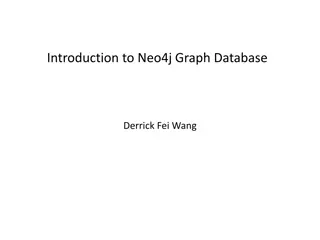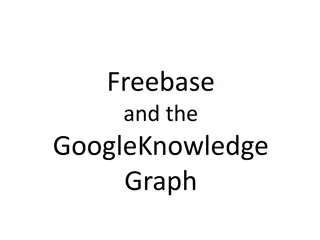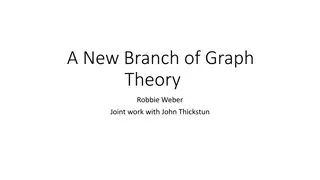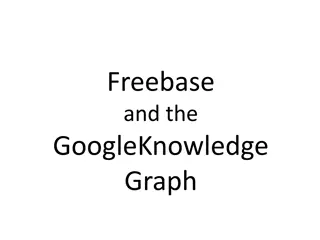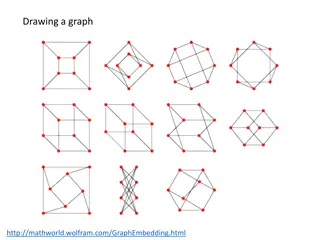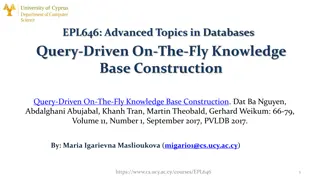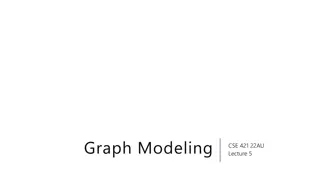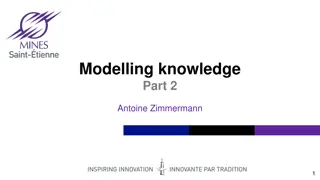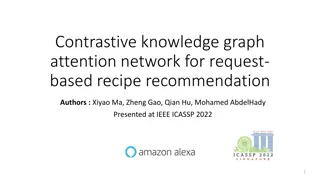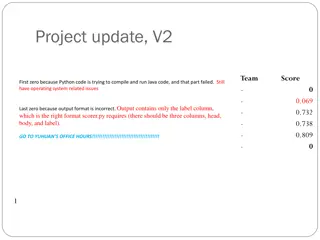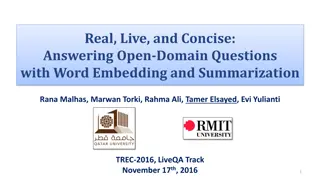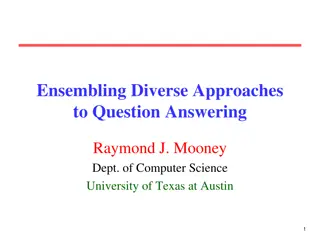Advancements in Knowledge Graph Question Answering for Materials Science
Investigating natural language interfaces for querying structured MOF data stored in a knowledge graph, this project focuses on developing strategies using NLP to translate NL questions to KG queries. The MOF-KG integrates datasets, enabling query, computation, and reasoning for deriving new knowledge, with a specific focus on MOF ontology. Sources for building MOF-KG include structured databases like CSD and scholarly articles describing MOF synthesis procedures. Knowledge Graph Question Answering (KGQA) aims to facilitate end users in posing natural language questions and receiving answers from KGs, reducing the technical barrier of writing Cypher queries. Existing KGQA systems leverage various methods like rule-based, template-based, and machine learning, with benchmark datasets crucial for evaluating performance and advancing the field.
Download Presentation

Please find below an Image/Link to download the presentation.
The content on the website is provided AS IS for your information and personal use only. It may not be sold, licensed, or shared on other websites without obtaining consent from the author. Download presentation by click this link. If you encounter any issues during the download, it is possible that the publisher has removed the file from their server.
E N D
Presentation Transcript
KNOWLEDGE GRAPH QUESTION ANSWERING FOR MATERIALS SCIENCE (KGQA4MAT) College of Computing and Informatics, MRC, Drexel University Dr. Yuan An, Dr. Jane Greenberg, Alex Kalinowski, Xintong Zhao, Dr. Xiaohua Hu ~ Dept. of Chemistry, University of Central Florida Dr. Fernando J. Uribe-Romo, Kyle Langlois, Jacob Furst ~ Dept. of Chemical and Biological Engineering, Colorado School of Mines Dr. Diego A. G mez-Gualdr n, 1
SCOPE In this project, we investigate natural language interfaces for querying structured MOF data stored in a MOF knowledge graph. With the exceptional NLP abilities of LLM, we develop and evaluate strategies to prompt LLM for translating NL questions to KG queries. 2
BUILDING A KNOWLEDGE GRAPH FOR MOF (MOF-KG) We built a knowledge graph that integrates disparate MOF databases and extracted property data and synthesis procedures from publications It enables query, computation, reasoning for deriving new knowledge 3
SOURCES FOR BUILDING MOF-KG Structured databases: Cambridge Structural Database (CSD) Materials Project MOFXDB CoRE MOF ToBaCCo More Unstructured data: scholarly articles describing MOF synthesis procedures 5
WHAT IS KNOWLEDGE GRAPH QUESTION ANSWERING (KGQA)? KGQA aims to enable end users to pose natural language questions and receive answers from knowledge graphs (KGs) The MOF-KG in the Neo4j platform requires a formal query language, Cypher, to access the information. Writing Cypher queries is a significant technical barrier for domain experts. It is crucial to devise a natural language query interface. 6
PROGRESS AND CHALLENGES Existing KGQA systems employ rule-based, template-based, machine learning, and deep learning methods. Benchmark datasets are crucial for evaluating the performance of KGQA systems and fostering advancements in the field. Well-known benchmark datasets: QALD series, LC-QuAD series, and SciQA. 7
PROGRESS AND CHALLENGES Our first task was to develop a benchmark data. Incorporate a diverse range of question types, domain-specific language, and complex relationships found within the MOFKG. Contains 161 unique questions each of which has 3 different variations, totaling 644 questions. Split the data into train and test sets by the ratio 80:20. 8
BUILDING THE KGQA4MAT BENCHMARK Leveraged the exceptional capacity of ChatGPT to generate questions and variations involving facts, comparison, superlative, and aggregation. Manually created corresponding Cypher queries 9
DEVELOPING LLM-BASED STRATEGIES FOR KGQA4MAT Employed zero-shot, few-shot, and chain-of- thought strategies. For few-shot learning, embedded all the training and test questions to compute the cosine similarity between the two questions. For chain-of-thought reasoning, instructed the LLM to generate the chain of thought for a given Cypher query, then refine the reasoning steps manually. 10
KGQA4MAT RESULTS Method Method 1: Zero-shot learning from MOF-KG ontology only Method 2: 1-shot learning from a pair of train question and query Method 3: 1-shot learning from the MOF-KG ontology and a pair of train question and query Method 4: 1-shot learning from a pair of train question and query, and the chain-of-thought of the train query Method 5: 1-shot learning from the MOF-KG ontology and a pair of train question and query, and the chain-of-thought of the train query F1 Score 0.411 0.829 0.845 0.876 0.891 11
EVALUATION ON QALD-9 QALD-9 contains natural language questions and corresponding SPARQL queries over DBpedia. A multilingual question answering benchmark containing 408 train questions and 150 test questions. Evaluated its English version of train and test questions. Assuming ChatGPT has already learned from Wikipedia and DBpedia ontology. 12
QALD-9 RESULTS Evaluation Method Baseline 1: SGPT Q,K, 2022, top 1 in the KGQA Leaderboard Baseline 2: SGPT Q, 2022, top 2 in the KGQA Leaderboard Baseline 3: Stage I No Noise, 2022, top 3 in the KGQA Leaderboard Baseline 4: GPT-3.5v3, 2023, top 6 in the KGQA Leaderboard Baseline 5: ChatGPT, 2023, top 7 in the KGQA Leaderboard Method 0: Answer the QALD-9 questions directly Method 1: Translate QALD-9 questions directly. Method 2: 1-shot learning from a pair of train question Method 3: 1-shot learning from a pair of train question and query, and the chain-of-thought of the train query F1-Score 0.67 0.60 0.55 0.46 0.45 0.33 0.30 0.40 0.66 13





